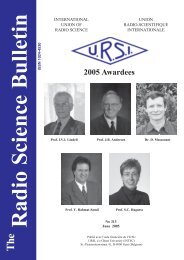Radio Science Bulletin 325 - June 2008 - URSI
Radio Science Bulletin 325 - June 2008 - URSI
Radio Science Bulletin 325 - June 2008 - URSI
- No tags were found...
You also want an ePaper? Increase the reach of your titles
YUMPU automatically turns print PDFs into web optimized ePapers that Google loves.
( ω kV j j)dx ∂i 0 + ∂ω0,= = + Vidt ∂k ∂ki( ω kV )dk ∂ + Vi∂ω∂=− =− −dt x x xi0 j j 0 jk j∂ i ∂ i ∂ i, (31)2∂VAk,2 ∂VkkVSj k A, jVS + ( kV j A,j)VStt∂V−∂∂+ k2 2 2 2jω ⎡0 2ωt0 − k ( VA+ V∂S )⎤⎢⎣⎥⎦The ray-tracing equations for the transverse Alfvénwave arej( ω kV )dω ∂ + ∂ωV= = +∂dt ∂t ∂t ∂t0 j j 0 jk j.dxdti=± V + V ,Ai ,iThis is the most general form of the ray-tracing equations.They can be integrated step-by-step to follow the path of awave packet. In steady-state flows, successive wave packetsfollow the same path so that the ray for a particular set ofstarting conditions is fixed in space. If the flow at a pointvaries with time, then this is not so, and successive wavepackets follow different paths. As written here, theseequations apply to any type of wave in a moving medium.If ω 0 is given by the dispersion relation of Equation (4), theequations describe magnetosonic waves. In this case, wecan write them explicitly as2( + ) ω0 −( , )2 2 2 2ω ⎡0 2ω0− ( A + S )⎡k V V k V kVdx ⎢i=⎣dt k V V ⎤⎢⎣⎥⎦2 2 2 2i A S j A j i S( kV )2 2j A, j kVSVAi,⎡ 2 2 2 20 2ω0− k V + V− + V ,iω ( A S )⎤⎢⎣⎥⎦⎤⎥⎦dk ∂ViAj , ∂Vj= kjkjdt # − , (33)∂x ∂xd ω VAj, V=± k∂ j + k∂jdt ∂t ∂twhere the upper sign corresponds to a wave propagatedparallel to, and the lower sign to one propagated antiparallelto, the magnetic field in the local rest frame.4. Some Numerical ExamplesIt is not the intention of this paper to provide detailednumerical solutions to specific magnetospheric problems.This will be the subject of further work. We provide twovery simple numerical examples that illustrate the technique,without the complexity of the most general case.4.1 Isotropic Alfvén Wave in aShear Layeriij,2 ⎡ ∂VAj, ∂VS⎤ω0 ⎢VAj, + VS⎥dki2∂xi∂xidt =−k⎣⎦2 2 2 2ω ⎡0 2ω0k ( V A V ⎤⎢− +⎣S ) ⎥⎦∂VkkV V ( kV ) V−2 Ak ,2j k Aj , S + j Aj , S∂xi2 2 2 2ω ⎡0 2ω0− k V + V ⎤⎢⎣( A S )⎥⎦∂V∂xSi−k2 ⎡ ∂VAj, ∂VS⎤ω0 ⎢VAj, + VS⎥dω2∂t∂tdt = k⎣⎦2 2 2 2ω ⎡0 2ω0k ( V A V ⎤⎢− +⎣S ) ⎥⎦j∂V∂xij(32)Consider a shear layer in a cold plasma (i.e., P andtherefore V S are zero), as illustrated in Figure 3a. Themagnetic field is uniform and in the y direction. The densityis also uniform, so that the Alfvén speed is constant. Theplasma has a velocity in the x direction that varies as afunction of z, thus forming a shear layer. This is a steadystateproblem, so that w is constant. If we make use of the2 2 2dispersion relation ω 0 = kVA, the ray-tracing equations,Equations (32) for an isotropic Alfvén wave (the fast wave),may be written2x Aω0dx kV= + V()z ,dtdydt2y AkV= ,ω030The<strong>Radio</strong> <strong>Science</strong> <strong>Bulletin</strong> No <strong>325</strong> (<strong>June</strong> <strong>2008</strong>)
















